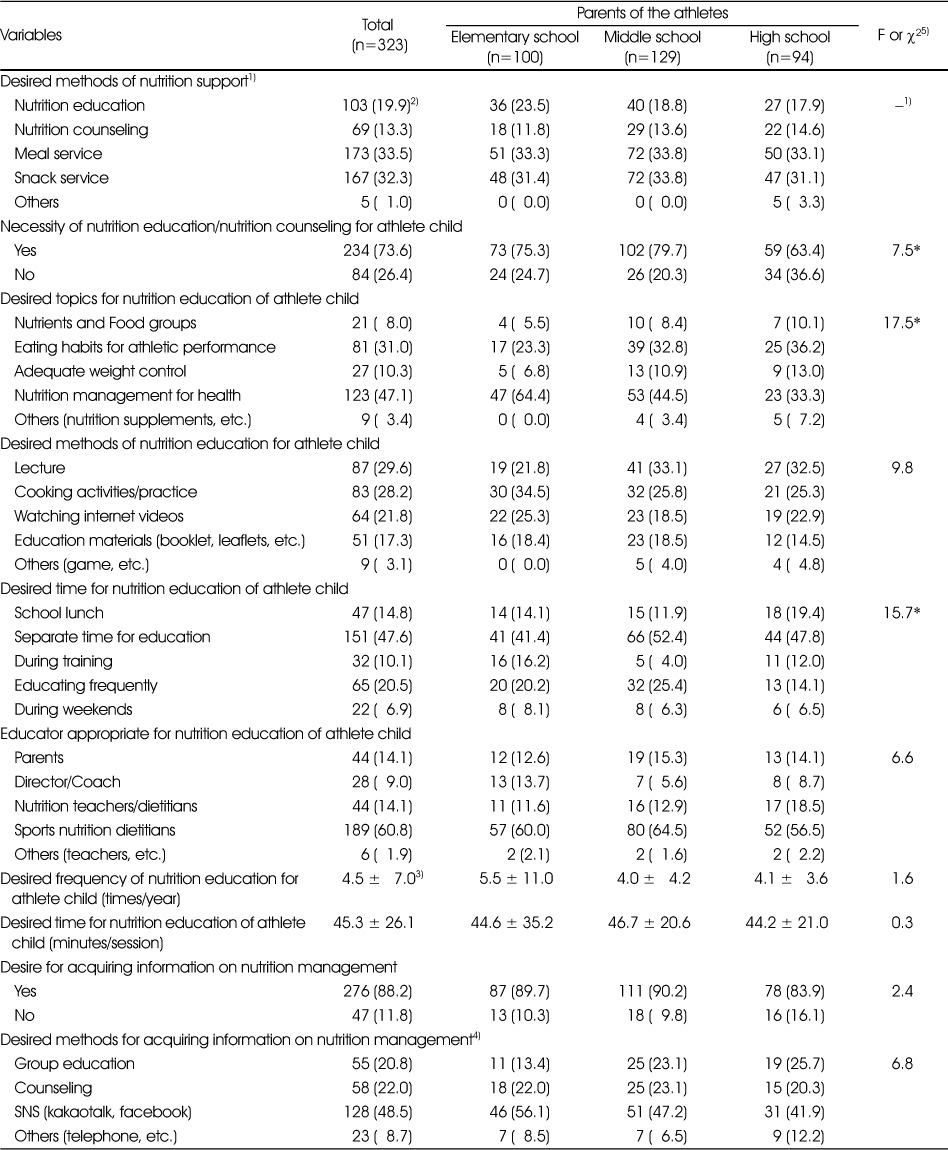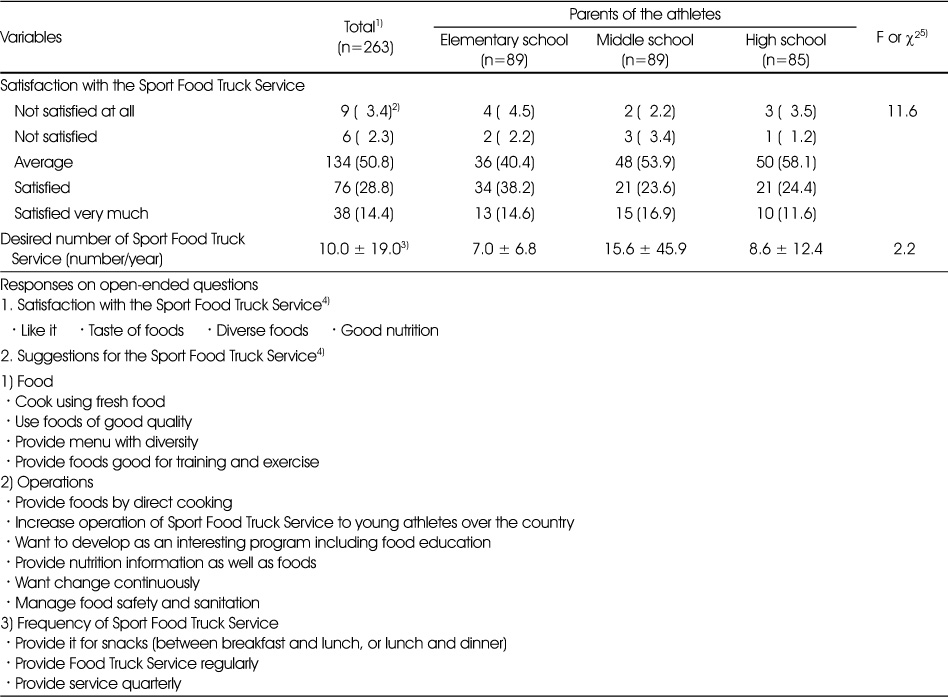References
1. Koo JO, Kim JH, Byun KW, Sohn CM, Lee JW, Lee JH, et al. Nutrition through the life cycle 1st edth ed. Seoul: Kyomunsa; 2011. p. 204p. 219–220.
p. 248–257.
2. Cotunga N, Vickery CE, McBee S. Sports nutrition for young athletes. J Sch Nurs 2005;21(6):323–328.
3. Chun YS, Lee KE, Back NS, Kim MS, Lee KW, Kim SY. The nutrition indigestion of the high school judo players in accordance to their weight, before and after the competition. J Korean Alliance Mart Arts 2010;12(3):299–310.
6. Yang IS, Lee HY, Kim HY, Kang YH. Setting instructional goals for nutritional education program through an analysis of problems identified in junior/senior high school students. Korean J Community Nutr 2003;8(4):495–503.
7. Ministry of Health and Welfare, Korea Centers for Disease Control and Prevention. Korea health statistics 2017: The 7th Korea National Health and Nutrition Examination Survey, the 2nd year(2017) Osong: Ministry of Health and Welfare; 2018. p. 205–211.
8. Cheong SH, Sung HI, Kim SK, Kim KH, Cho MH, Chang KJ. Eating behaviors, perception of body image, hematological indices and nutrient intake of adolescent female athletes in Incheon. Korean J Community Nutr 2003;8(6):951–963.
9. Hwang SH, Jung KA, Kim C, Ahn HC, Chang YK. The status of nutrient and food intakes and the nutritional knowledge in adolescent rhythmic gymnasts. Korean J Nutr 2004;37(6):479–492.
10. Lee JS, Kim MH, Bae YJ, Choe YH, Sung CJ. A study of dietary habits, nutrition intake status and serum copper and zinc concentrations of adolescent athletes. Korean J Nutr 2005;38(6):465–474.
11. Ahn NY, Kim KJ. Effects of health education for the nutrient intakes and eating habits in youth athletes. J Coach Dev 2011;13(1):277–282.
12. Ko KM, Kim SB. Effects of nutrition education providing school lunch by personalized daily needed food exchange units for adolescent athletes in Jeonbuk province. Korean J Community Nutr 2016;21(1):25–36.
13. Parks RB, Helwig D, Dettmann J, Taggart T, Woodruff B, Horsfall K, et al. Developing a performance nutrition curriculum for collegiate athletics. J Nutr Educ Behav 2016;48(6):419–424.
14. Brown ML, Tenison E. Creation of a dual-purpose collegiate athlete nutrition advising program and educational curriculum. J Nutr Educ Behav 2018;50(10):1046–1052.
16. Park SU, Lee SJ, Yoo SH. A study on the nutritional knowledge, eating habits, food preferences, and nutritions intake of Taekwondo players. J Korea Sport Res 2004;15(6):841–852.
17. Sohn JY, Lee YS, Lee YJ, Jung SH, Jun JY, Kim YS, et al. Healthy family educational need and life satisfaction of middle school students and their parents. J Korean Home Econ Educ Assoc 2006;18(1):95–111.
18. Kim HJ, Kim HA. Perception of nutritional education among school administrators, parents, and school nutrition teachers at an elementary school. J Korean Diet Assoc 2012;18(4):385–399.
19. An HS, Kim KL, Lim YM. An analysis on the requirements of the contents of elementary school health education in teachers, parents and students. Korean J Elem Phys Educ 2013;18(4):51–61.
20. Oh NG, Gwon SJ, Kim KW, Sohn CM, Park HR, Seo JS. Status and need assessment on nutrition & dietary life education among nutrition teachers in elementary, middle and high schools. Korean J Community Nutr 2016;21(2):152–164.
21. Prochaska JO, Redding CA, Evers KE. The transtheoretical model and stages of change. In : Glanz K, Rimer BK, Viswanath K, eds. Health behavior and health education: Theory, research, and practice 4th edth ed. San Francisco, CA: Jossey Bass; 2008. p. 97–122.
22. Cho SS. Optimal nutrition for sports and exercise. Korean J Community Nutr 2002;7(3):410–420.
23. Shin EK, Shin KH, Kim HH, Park YH, Bae IS, Lee YK. A survey on the needs of educators, learners and parents for implementing nutrition education by nutrition teachers in elementary schools. J Korean Diet Assoc 2006;12(1):89–101.
24. Her ES. Eating behavior, nutrition knowledge, and educational needs of the food and nutrition of elementary school students in the Gyeungnam province. Korean J Community Nutr 2013;18(1):11–24.
25. Lee JS. Present food service state for athletes in Korea. Korean J Community Nutr 2002;7(3):421–426.
26. Choi MK, Bae YJ, Kim MH, In SJ. A survey of the needs of nutrition education based on analysis of eating habits and nutrition knowledge among middle school students in Kyung-Gi province. J Korean Diet Assoc 2010;16(2):133–145.
27. Kim HH, Park YH, Shin EK, Shin KH, Bae IS, Lee YK. Students' and parents' perceptions of nutrition education in elementary schools. J Korean Soc Food Sci Nutr 2006;35(8):1016–1024.
28. Cho S, Lee HJ. Development of dietary schedule for improved nutritional support during training period of junior & senior high school fencers in Ulsan city. J Korean Diet Assoc 2011;17(1):32–46.
29. Lee KY, Bae YJ, Choi MK, Kim MH. Satisfaction on school meal service and food preference of elementary school students in Chungnam. Korean J Food Nutr 2017;30(1):129–138.
30. Lee JH, Lee EH, Choe EO. Study on eating habits and food preference for breakfast of elementary, middle, or high school students in the Incheon area. Korean J Food Cookery Sci 2014;30(2):170–182.
31. Sung YS, Bae JH. Eating habits and food preferences of certain middle school students in Daegu area. Korean J Food Nutr 2011;24(3):312–319.
32. Park CH, Jin KW, Kang HS. A comparative study of the mode of nutrition intake, recovery, and fitness training for conditioning by the level of soccer players. Korean J Sport 2018;16(1):571–581.






